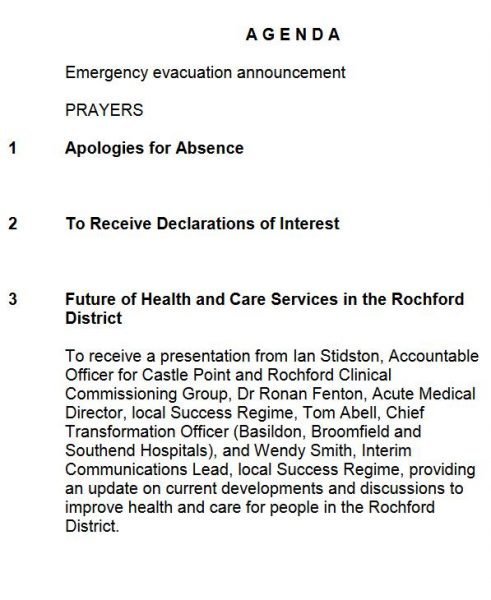The special District Council meeting to discuss the proposed downgrading of Southend A&E is this Thursday at 7:30 pm at the Civic Suite in Rayleigh (opposite the church).
If you have any questions you would like us to ask, or any views you would like us to put forward – especially if you are a health care professional – please leave a comment here or email us.


I want to know whether the success regime has looked into the increased risk of mortality (10% per 10 kilometres) in stroke and myocardial infarction patients. This would mean an increased mortality risk for patients from Southend and from Chelmsford of 30%. It is important to know who will be legally accountable for this increase in deaths. It is very important that someone is made liable for prosecution over every single avoidable death!
Basildon A&E is at breaking point and doesn’t need more patients. Chelmsford is a city in it’s own right and needs an A&E as does highly populated Southend. When will those in power put people before profit?
Please read this – from p70 and 71 of the following research documenthttp://www.lsbu.ac.uk/__data/assets/pdf_file/0019/114409/sustainability-and-transformation-plans-critical-review.pdf?t=1 What does the evidence show?
First looking at quality of care, in the case of emergency care, centralisation may have a negative impact with mortality increasing the greater distances that have to be travelled. Thus Harrison (2012) has found,
“Even if gains in outcomes are achieved by centralization, the longer journey times that it entails for some patients may offset set them to some extent. One study of stroke care found that the clinical risks of longer journeys outweighed the benefits of centralization. Nicholl et al. found that for every mile a seriously injured person had to travel to hospital, the risk of death increased by one per cent. Other work has found that the longer journeys discouraged use of health-care services†(p4).
A more recent report, Future Fit, for the West Midlands Clinical Senate (Shropshire, Telford and Wrekin Defend Our NHS, 2016) confrms this, pointing out that Nicholl’s study in 2007
A Critical Review 71
(Nicholl et al., 2007) is one of the more important pieces of UK research on the relationship between journey length and mortality. This looked at survival rates for patients with life-threatening conditions, relating this to the distance between home and hospital. For patients travelling up to 10 km, the overall mortality rate was 5.8%; for those travelling 11-20 km, 7.7% died; and for those travelling 21 km or more, 8.8% died. Overall, people who travelled more than 20 km to access treatment were 50% more likely to die than those living close to the hospital. Those with acute respiratory conditions fared even worse, and were around twice as likely to die if they had to travel the longer distance to access A&E.
Future Fit reports,
“More recent research confirms the pattern. A 2013 Japanese study looked at distance to hospital for patients with acute heart attacks, strokes and pneumonia – a sub-set of the conditions examined by the She eld study. The study found a strong correlation between transport distance and mortality for acute heart attack and for ischaemic stroke; and a moderate correlation between distance and mortality for pneumonia and for subarachnoid haemorrhage†(p16).
And goes on to draw attention to a 2014 York University analysis of Swedish data that,
“… compared survival rates from myocardial infarction for people having to travel different distances to emergency care. The author concluded ‘The results show a clear and gradually declining probability of surviving an acute myocardial infarction as residential distance from an emergency room increases’. People travelling 50 to 60 km to emergency care were 15% less likely to survive than those living close to the hospital. Most of the excess deaths were of people dying on the way to hospital. The author noted an inherent bias in much medical research, as studies typically look only at outcomes for people who arrive alive at hospital. Those who die on the way are excluded. Most research also takes place in urban areas, with little research on the impact on survival of rurality and/or
long journey distance. The few studies that do exist strongly support the case that longer journeys to A&E result in higher rates of mortalityâ€.
Finally Future Fit refers to,
“… evidence from the USA of Emergency Department closure having a strong ‘ripple e ect’, with mortality increasing by 5% for patients at neighbouring Emergency Departments that remained open. Existing facilities can easily be overwhelmed by increased demand.
A strong and growing body of anecdotal UK evidence is of severe pressure on A&Es that remain following the closure of a neighbouring unitâ€.
Candace Imison’s report from the King’s Fund makes similar points (Imison et al., 2014),
“There have been very few studies to assess the impact of centralising A&E services. The limited evidence available suggests that if services are centralised, there are risks to the quality of care where the centralised service does not have the necessary A&E capacity and acute medical support for the additional workload. A proportion of A&E attenders can safely be seen in community settings, but there is little evidence that developing these services in addition to A&E will reduce demandâ€.
Thank you Kate, I will study this carefully.
There is another study you may not be aware of ( Prof Oz – the use of common sense, University of Life, 2017 ) which stated that the longer a very seriously ill person spends in a ambulance on the A127 in the rush hour the less chance they will survive.